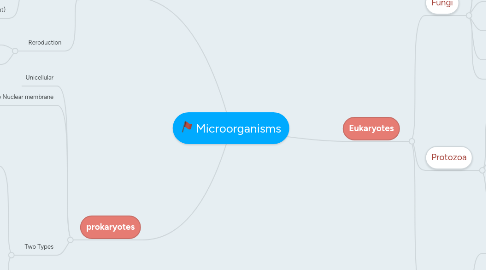
1. prokaryotes
1.1. Unicellular
1.2. No Nuclear membrane
1.3. Two Types
1.3.1. Archea
1.3.1.1. Cell wall
1.3.1.1.1. If present, lack peptidoglycan layer
1.3.1.2. Three Types
1.3.1.2.1. methanogens
1.3.1.2.2. extreme halophiles
1.3.1.2.3. extreme thermophiles
1.3.2. Bacteria
1.3.2.1. Cell wall
1.3.2.1.1. peptidoglycan layer
1.3.2.2. Shape
1.3.2.2.1. Bacillus
1.3.2.2.2. Some are star or square shaped.
1.3.2.3. Replication
1.3.2.3.1. can form pairs, chains or clusters characteristic to a senus or species
1.3.2.3.2. Binary fission
1.3.2.4. Nutrition
1.3.2.4.1. Mostly from organic materials
1.3.2.4.2. Some use photosynthesis
1.3.2.4.3. Some use inorganic materials
1.3.2.5. Locomotion
1.3.2.5.1. Flagella
2. Viruses
2.1. Very small
2.2. Acellular
2.3. Structure
2.3.1. Core
2.3.1.1. DNA
2.3.1.2. RNA
2.3.2. Protein coat
2.3.3. envelope( may be absent)
2.4. Reroduction
2.4.1. by using the cellular machinery of other organisms
2.4.2. remains inert outside living hosts
3. Eukaryotes
3.1. Fungi
3.1.1. Cell wall
3.1.1.1. Chitin
3.1.2. Unicellular(yeast)
3.1.2.1. Shape
3.1.2.1.1. oval
3.1.2.1.2. larger than bacteria
3.1.3. Multi cellular(molds)
3.1.3.1. Shape
3.1.3.1.1. visiable masses called mycelia
3.1.4. Reproduction
3.1.4.1. Sexual
3.1.4.2. Asexual
3.1.5. Nutrients
3.1.5.1. solutions of organic materials
3.1.6. Slime molds have similarity with the amoebas
3.2. Protozoa
3.2.1. Reproduction
3.2.1.1. Sexual
3.2.1.2. Asexual
3.2.2. Nutrients
3.2.2.1. Photosynthesis
3.2.2.2. Absorption
3.2.2.2.1. parastic
3.2.2.2.2. free entities
3.2.3. Locomotion
3.2.3.1. Pseudopods
3.2.3.2. Flagella
3.2.3.3. Cilia
3.3. Algea
3.3.1. Cell wall
3.3.1.1. Cellulose
3.3.2. Reproduction
3.3.2.1. Sexual
3.3.2.2. Asexual
3.3.3. Nutrients
3.3.3.1. photosynthesis
3.3.4. provide oxygen and carbohydrates
